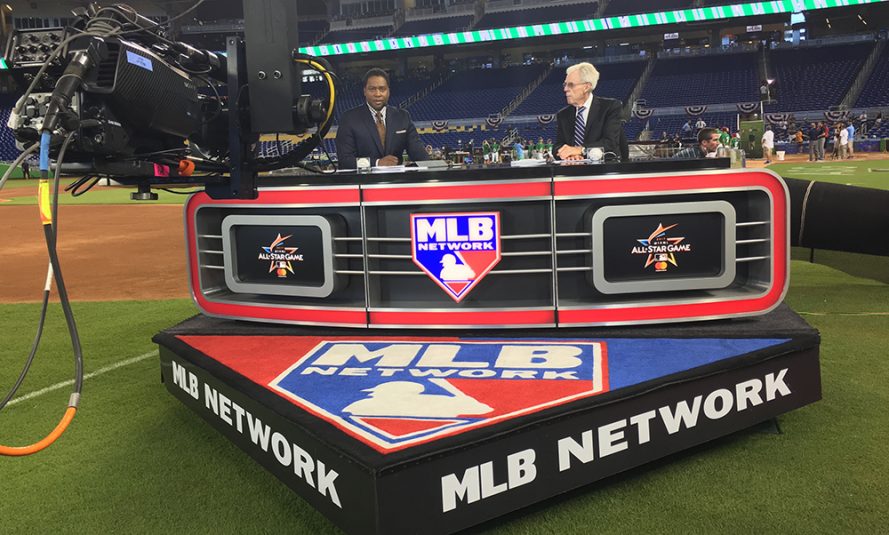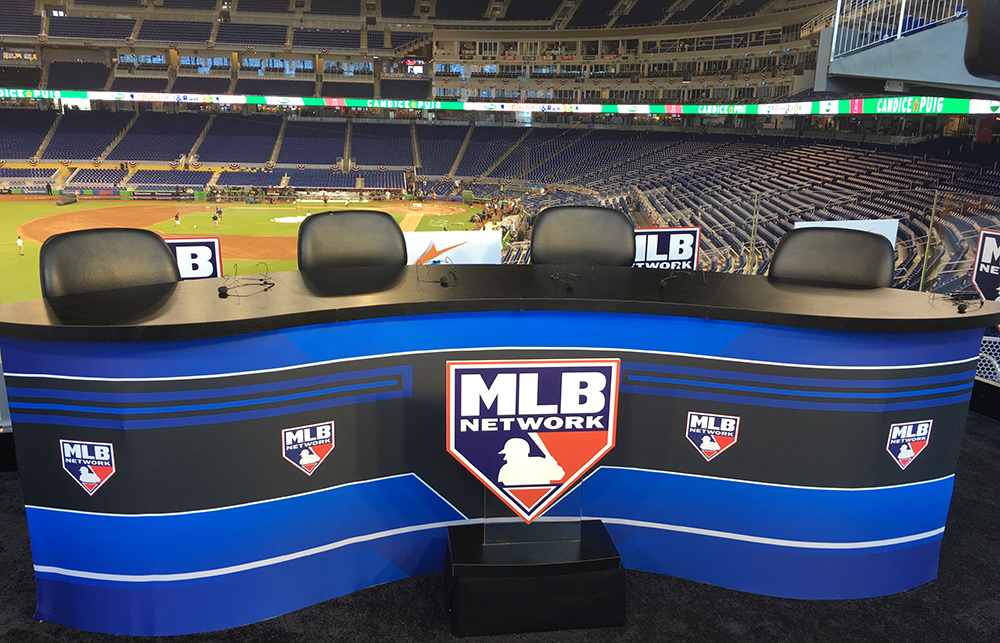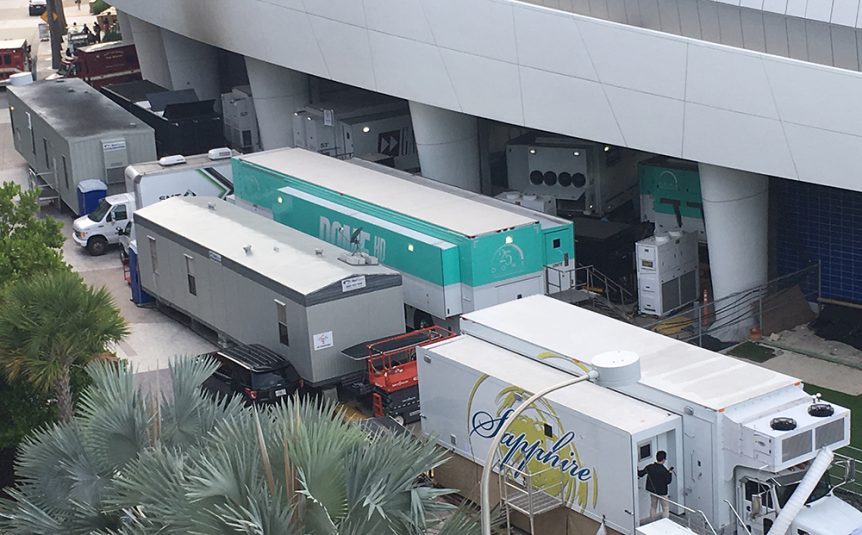Live From MLB All-Star: MLB Network Adds Full Media Day Coverage to Packed Live-Programming Slate
Tech innovations include launch of ‘FATS’ content-sharing system, full Dante IP audio, and new RF monitors for talent
Story Highlights
MLB Network’s already extensive live coverage from the MLB All-Star festivities have expanded this year, with All-Star Media Day shifting to Marlins Park and live coverage extending on Monday. Traditionally held at a nearby hotel, Media Day at the ballpark added two hours to MLB Network’s annual cavalcade of live All-Star programming: Sunday’s All-Star Futures Game; onsite editions of MLB Tonight (pre/postgame), Intentional Talk, and High Heat; and the All-Star Red Carpet Show. Add in oversight of the world feed for the All-Star Game itself, and it becomes obvious just how big this week is for MLB Network.
“This is a huge setup for us, definitely bigger than the World Series,” says Susan Stone, VP, operations and engineering, MLB Network. “This is baseball’s big party, and we [cover] it that way. The big difference is Media Day coverage, which we think we are handling pretty creatively and are very excited about.”
In addition to increasing overall live programming, MLB Network has rolled out innovative technology: a new FATS (feed another trailer something) system to streamline sharing of video feeds among onsite broadcasters, a full Dante IP audio system for on-field coverage, Zullavision RF monitors that allow talent to view live video feeds, Blast Motion Bat Metric Tracking, and the use of MLBAM’s Statcast and Pitchcast for the Futures Game.
All-Star Media Day All About Robos
With the addition of All-Star Media Day, MLB Network’s live coverage began two hours earlier than last year — at 2 p.m. ET. To cover the slew of player-interview podiums along the outfield wall, the network brought in eight Fletcher robotic cameras, which were also distributed to Fox and ESPN.
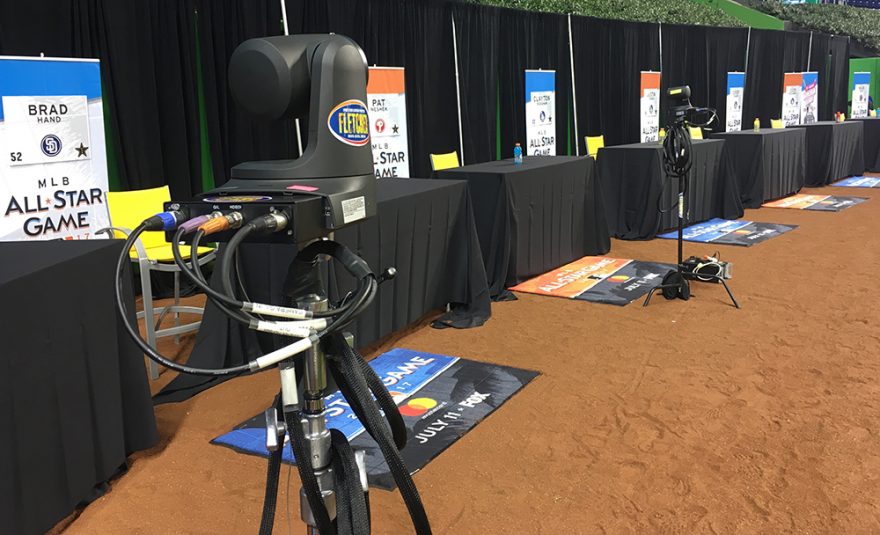
MLBN enlisted Fletcher Sports to provide eight robotic cameras to cover the player podium at Media Day in the Marlins Park outfield.
“In the past, we had two cameras in the press-conference room and a podium for announcers and for Q&A, but everything else was ENG coverage,” Stone notes. “But baseball really wanted to make Media Day bigger and more part of the whole event. And we’ve all felt for years that it was crying out to be on the field in the ballpark, so we’re really excited about bringing it live to the fans.”
It’s the Good Kind of FATS
With ESPN, Fox, MLBN, MLBAM, the MLBN world feed, and international rightsholders like NHK onsite, there is a massive amount of video-feed sharing. In an effort to centralize mass distribution of all these feeds, Jason Hedgcock, senior manager, remote technical operations, MLB Network, has pioneered the launch of a FATS system. Although such systems have been used on large events in the past to help alleviate the strain of distributing feeds to individual networks for long periods, having a different main host broadcaster each day at All Star creates unique challenges.
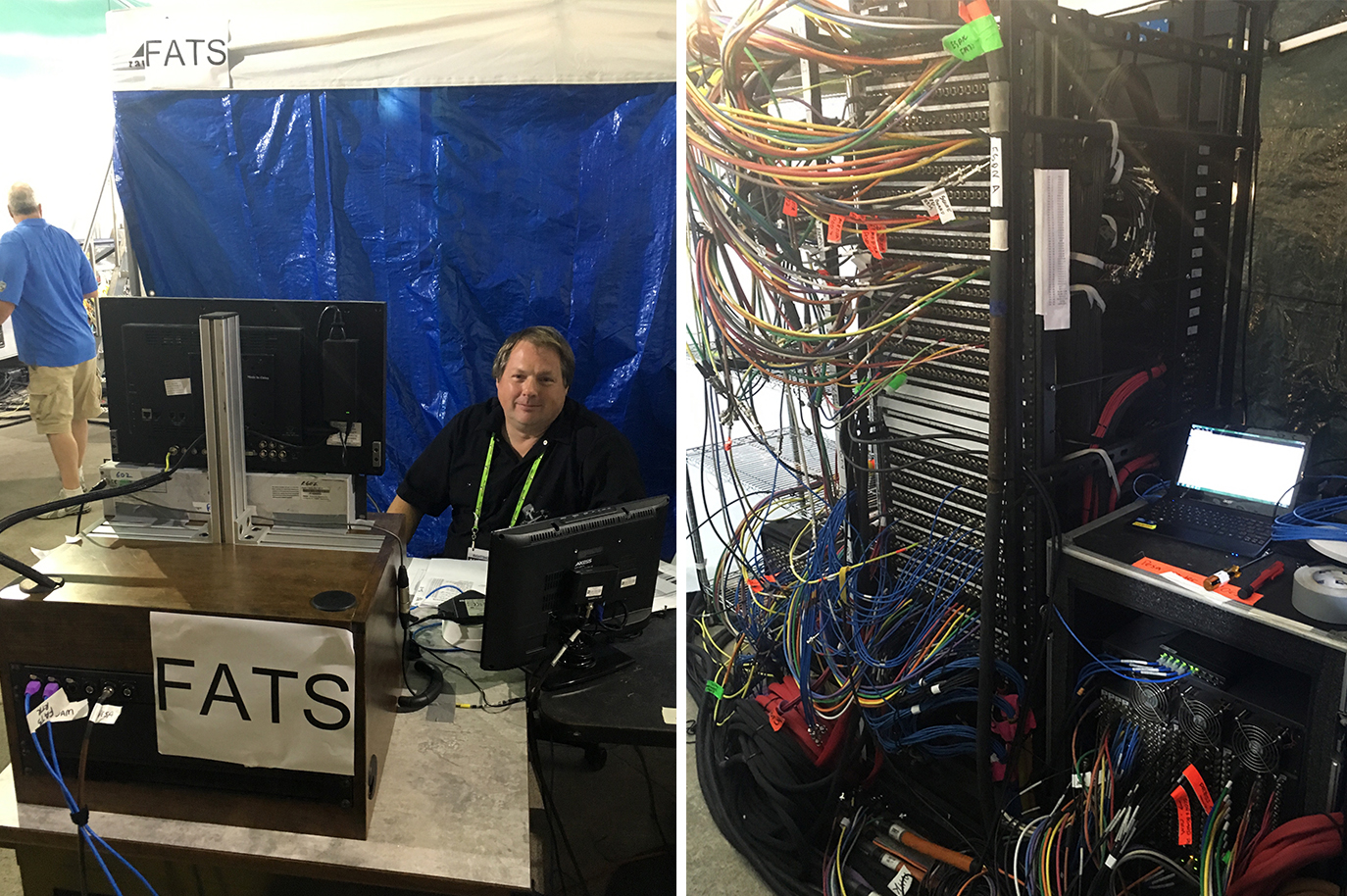
Engineer Jeff Leonard (left) mans the FATS station (right) inside the primary All-Star production compound at Marlins Park.
There is already more than 30,000 ft. of fiber to connect all the compound lots to the main I/O. Using a FATS model, each broadcaster has been able to fully utilize resources without additional fiber connecting truck to truck.
“If you need [a feed], you can just go talk to the dedicated engineer at the [FATS] tent, and they get you want you need since they have it all in one place,” explains Hedgcock. “The other part that’s nice is, [at] game time, somebody always realizes they need something that they don’t have. Now, instead of trying to pull video [resources] away from the show that just came on-air, they can go to the FATS tent and get the right feed. There is a standalone entity to get that out to everybody without any issues.”
‘A Game-Changer’: Moving to Dante IP Audio
As in years past, MLB Network has its traditional pregame field set on the third-base side at Marlins Park and a secondary set in the promenade for postgame. This year, for the first time, audio for MLB Network studio shows is based entirely on Dante IP. This significantly reduced the weight the fiber cart (launched last year) that is rolled out onto the field to serve the pregame show’s audio needs.
“We looked at the fiber[-cart] model after last year and decided it was great but it was too heavy,” says Hedgcock. “By going to Dante, we reduced all the power supplies and dropped the weight substantially. It’s been great for us, and we’ve ironed out a few wrinkles. The clarity and quality are better than what we’ve gotten from anything else; you can hear the difference in audio.”
The Dante-based system was tested at World Baseball Classic and fully deployed for NHL Network’s Stanley Cup Final coverage (which is handled by MLBN). Since the set and fiber cart must be broken down extremely quickly between signoff and first pitch, the lighter-weight fiber cart has substantially improved MLB’s pregame operation.
“The fiber [cart] was a game-changer for us because, when we first launched, we needed a large section in a [fiber] well at the ballpark,” says VP, Remote Operations, Tom Guidice. “For big events like All-Star and the World Series, there just isn’t room for that. At a place like Wrigley Field [for the World Series], I don’t know what we would have done without that [fiber cart]. And now it’s just plug and play. We used to run two TAC-12 [fiber cables]; now it’s just eight strands — and that’s with spares built in. The great part is, a lot of the new ballparks have that infrastructure so we don’t have to run it, which is a huge time and cost saving.”
Game Creek Video’s Riverhawk and Edit 3 mobile units, which serve the weekly MLB Network Showcase package, serve as MLBN’s production hub. The trucks are equipped with 10 EVS servers fully integrated with MLBN headquarters in Secaucus, NJ, via EVS Xplore.
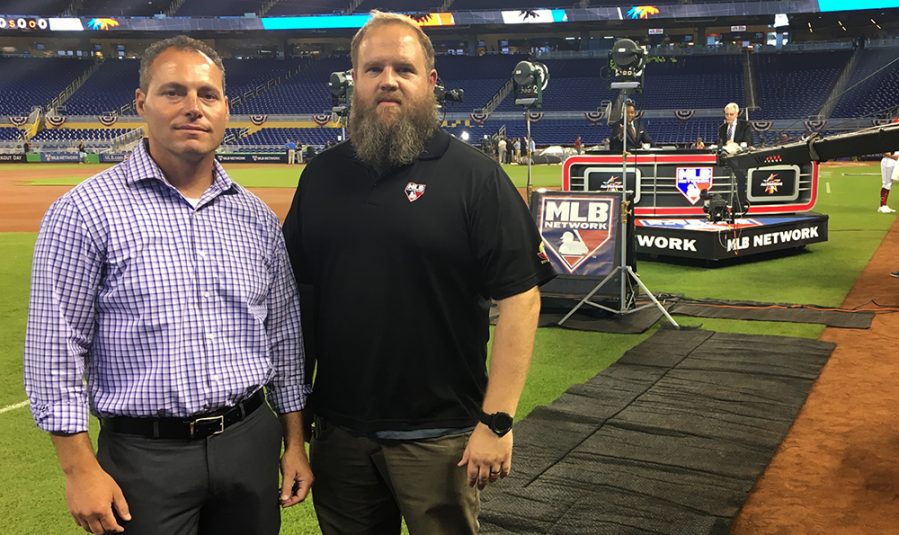
MLBN’s Tom Guidice and Jason Hedgcock on hand at network’s primary All-Star pregame set on the third-base line at Marlins Park.
For on-field coverage during pregame and for the world feed, MLB has deployed 12 hard cameras and seven handhelds in various configurations (including a jib), as well as two RF handhelds and two live RF cams for in-net batting practice provided by CP Communications.
Standalone Production for Red-Carpet Coverage
With Media Day moved to the ballpark, The Red Carpet Show, traditionally held near the host ballpark, has moved away. The parade will begin at the JW Marriott on Tuesday, roll down 0.9 miles of Biscayne Blvd, and terminate at the American Airlines Arena (3 miles from Marlins Park). As a result, MLB Network is running its live-to-tape coverage as a standalone production for the first time since Kansas City in 2012. AVS is providing a fixed-wing aircraft for aerial coverage.
Operating out of Game Creek Apollo, the production features a standup interview position near Bayfront Park hosted by Heidi Watney (with an RF handheld), two roaming handhelds following the parade down Biscayne Blvd and another on a scissor lift halfway through the route, and a host location on a Z stage at American Airlines Arena featuring a jib, two pedestal cameras, and a wired handheld.
“[The Red Carpet Show] adds a little more complexity for us because we have run a fairly integrated compound at All-Star in the past,” says Hedgcock. “We bring our international trucks and our red-carpet trucks in with our primary trucks, and we try to share our resources. Now we have an island in another part of the town, which presented some unique challenges, but we’ve accounted for them well.”
Zullavision Sets On-Air Talent Free To Roam
Also new for MLBN are Zullavision RF tablets that allow talent to view live video feeds while roaming around the ballpark. MLBN is distributing quad feeds to the tablets, and talent can select any of them to go full-screen. MLBN sideline talent has been using the technology on the weekly Showcase game.
“The talent is running around a lot at this event and could literally be in centerfield during batting practice, but, sometimes, the truck wants to show them something in advance. They have the ability to do that now,” says Guidice. “And nobody in the truck has to route it; it’s just there on the [tablet]. They have control of it, and they can walk around with it wherever they want.”
Perfecting the World Feed
In addition to its own coverage, MLBN is now in year three of overseeing production of the world feed (year two of being fully responsible for all the technical aspects). Dome Productions’ Journey and Unite mobile units are in the main compound to serve as home to world-feed production, with the MLB Network Showcase production team working the All-Star Game and the Futures Game. And, while the absence of MLB International VP/EP Russell Gabay, who died unexpectedly last year, looms large, the MLBN world-feed production continues to mature.
“Obviously, there’s always going to be a missing presence with Russell not here, and we all miss him greatly,” says Stone. “But [Director, International Broadcast Operations,] Judy Acone has really stepped up to the plate and taken over a lot of those responsibilities in terms of liaising with all global rightsholders. We’ve done this a couple of times now, and we’ve learned some lessons. The biggest issue for us is always all the transmission and all the different signage paths that we have to account for, but we feel like we’re in really good shape.”
